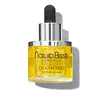What's inside
What's inside
 Key Ingredients
Key Ingredients

 Benefits
Benefits

 Concerns
Concerns

 Ingredients Side-by-side
Ingredients Side-by-side

Coco-Caprylate/Caprate
EmollientCaprylic/Capric Triglyceride
MaskingIsopropyl Myristate
EmollientSqualane
EmollientDimethyl Isosorbide
SolventHydroxypinacolone Retinoate
Skin ConditioningRetinol
Skin ConditioningDiacetyl Boldine
Skin ConditioningTocopherol
AntioxidantGlycine Soja Oil
EmollientPPG-26-Buteth-26
Skin ConditioningPEG-40 Hydrogenated Castor Oil
EmulsifyingOlea Europaea Fruit Oil
MaskingCocos Nucifera Oil
MaskingHelianthus Annuus Seed Oil
EmollientLinum Usitatissimum Seed Oil
PerfumingOryza Sativa Bran Oil
EmollientPrunus Amygdalus Dulcis Oil
Skin ConditioningVitis Vinifera Seed Oil
EmollientWater
Skin ConditioningBHT
AntioxidantGlycerin
HumectantDiamond Powder
AbrasiveXanthan Gum
EmulsifyingSodium Benzoate
MaskingLactic Acid
BufferingPotassium Sorbate
PreservativeParfum
MaskingCoco-Caprylate/Caprate, Caprylic/Capric Triglyceride, Isopropyl Myristate, Squalane, Dimethyl Isosorbide, Hydroxypinacolone Retinoate, Retinol, Diacetyl Boldine, Tocopherol, Glycine Soja Oil, PPG-26-Buteth-26, PEG-40 Hydrogenated Castor Oil, Olea Europaea Fruit Oil, Cocos Nucifera Oil, Helianthus Annuus Seed Oil, Linum Usitatissimum Seed Oil, Oryza Sativa Bran Oil, Prunus Amygdalus Dulcis Oil, Vitis Vinifera Seed Oil, Water, BHT, Glycerin, Diamond Powder, Xanthan Gum, Sodium Benzoate, Lactic Acid, Potassium Sorbate, Parfum
Ethylhexyl Stearate
EmollientCetearyl Ethylhexanoate
EmollientPPG-3 Myristyl Ether
EmollientPunica Granatum Seed Oil
EmollientCalendula Officinalis Flower Extract
MaskingSalicyloyl Phytosphingosine
Skin ConditioningSalvia Hispanica Seed Oil
MoisturisingAmaranthus Caudatus Seed Extract
Skin ConditioningAlaria Esculenta Extract
Skin ProtectingTocopheryl Acetate
AntioxidantHelianthus Annuus Seed Oil
EmollientGlyceryl Linoleate
EmollientGlyceryl Linolenate
EmollientDaucus Carota Sativa Seed Oil
EmollientDaucus Carota Sativa Root Extract
Skin ConditioningBeta-Carotene
Skin ConditioningTocopherol
AntioxidantRosmarinus Officinalis Leaf Extract
AntimicrobialCaprylic/Capric Triglyceride
MaskingOctadecyl Di-T-Butyl-4-Hydroxyhydrocinnamate
AntioxidantBenzotriazolyl Dodecyl P-Cresol
UV AbsorberDilauryl Thiodipropionate
AntioxidantParfum
MaskingLinalool
PerfumingCoumarin
PerfumingAmyl Cinnamal
PerfumingLimonene
PerfumingEthylhexyl Stearate, Cetearyl Ethylhexanoate, PPG-3 Myristyl Ether, Punica Granatum Seed Oil, Calendula Officinalis Flower Extract, Salicyloyl Phytosphingosine, Salvia Hispanica Seed Oil, Amaranthus Caudatus Seed Extract, Alaria Esculenta Extract, Tocopheryl Acetate, Helianthus Annuus Seed Oil, Glyceryl Linoleate, Glyceryl Linolenate, Daucus Carota Sativa Seed Oil, Daucus Carota Sativa Root Extract, Beta-Carotene, Tocopherol, Rosmarinus Officinalis Leaf Extract, Caprylic/Capric Triglyceride, Octadecyl Di-T-Butyl-4-Hydroxyhydrocinnamate, Benzotriazolyl Dodecyl P-Cresol, Dilauryl Thiodipropionate, Parfum, Linalool, Coumarin, Amyl Cinnamal, Limonene
Ingredients Explained
These ingredients are found in both products.
Ingredients higher up in an ingredient list are typically present in a larger amount.
This ingredient is an emollient, solvent, and texture enhancer. It is considered a skin-softener by helping the skin prevent moisture loss.
It helps thicken a product's formula and makes it easier to spread by dissolving clumping compounds.
Caprylic Triglyceride is made by combining glycerin with coconut oil, forming a clear liquid.
While there is an assumption Caprylic Triglyceride can clog pores due to it being derived from coconut oil, there is no research supporting this.
Learn more about Caprylic/Capric TriglycerideHelianthus Annuus Seed Oil is the oil derived from the seeds of a Sunflower. Sunflower seed oil is non-fragrant. It is an emollient, meaning it helps to soften the skin.
Sunflower seed oil contains many fatty acids. The fatty acids found in sunflower seeds include (from highest amount to least): linoleic acid, myristic acid, palmitic acid, stearic acid, arachidic acid, oleic acid, and linolenic acid.
These fatty acids help the skin create ceramides. Ceramides play a role in repairing the skin barrier.
Helianthus Annuus Seed Oil helps moisturize the skin. This in turn helps the skin look more rejuvenated and smoother.
Sunflowers are rich in vitamin E.
Historians believe Indigenous cultures of North America domesticated sunflowers before corn. Thus they relied on sunflower oil for a variety of uses. One such use is moisturizing skin and hair.
Sunflower seed oil may not be fungal acne safe. We recommend speaking with a professional if you have any concerns.
Learn more about Helianthus Annuus Seed OilParfum is a catch-all term for an ingredient or more that is used to give a scent to products.
Also called "fragrance", this ingredient can be a blend of hundreds of chemicals or plant oils. This means every product with "fragrance" or "parfum" in the ingredients list is a different mixture.
For instance, Habanolide is a proprietary trade name for a specific aroma chemical. When used as a fragrance ingredient in cosmetics, most aroma chemicals fall under the broad labeling category of “FRAGRANCE” or “PARFUM” according to EU and US regulations.
The term 'parfum' or 'fragrance' is not regulated in many countries. In many cases, it is up to the brand to define this term.
For instance, many brands choose to label themselves as "fragrance-free" because they are not using synthetic fragrances. However, their products may still contain ingredients such as essential oils that are considered a fragrance by INCI standards.
One example is Calendula flower extract. Calendula is an essential oil that still imparts a scent or 'fragrance'.
Depending on the blend, the ingredients in the mixture can cause allergies and sensitivities on the skin. Some ingredients that are known EU allergens include linalool and citronellol.
Parfum can also be used to mask or cover an unpleasant scent.
The bottom line is: not all fragrances/parfum/ingredients are created equally. If you are worried about fragrances, we recommend taking a closer look at an ingredient. And of course, we always recommend speaking with a professional.
Learn more about ParfumTocopherol (also known as Vitamin E) is a common antioxidant used to help protect the skin from free-radicals and strengthen the skin barrier. It's also fat soluble - this means our skin is great at absorbing it.
Vitamin E also helps keep your natural skin lipids healthy. Your lipid skin barrier naturally consists of lipids, ceramides, and fatty acids. Vitamin E offers extra protection for your skin’s lipid barrier, keeping your skin healthy and nourished.
Another benefit is a bit of UV protection. Vitamin E helps reduce the damage caused by UVB rays. (It should not replace your sunscreen). Combining it with Vitamin C can decrease sunburned cells and hyperpigmentation after UV exposure.
You might have noticed Vitamin E + C often paired together. This is because it is great at stabilizing Vitamin C. Using the two together helps increase the effectiveness of both ingredients.
There are often claims that Vitamin E can reduce/prevent scarring, but these claims haven't been confirmed by scientific research.
Learn more about Tocopherol